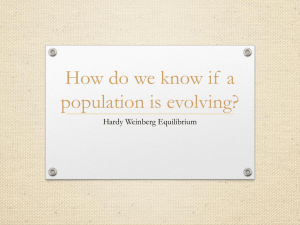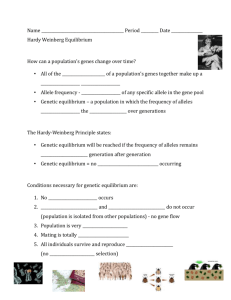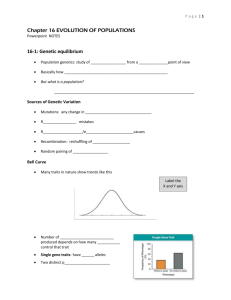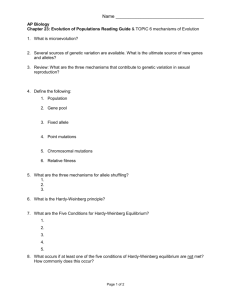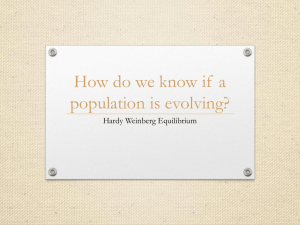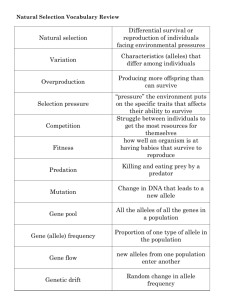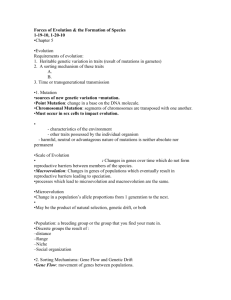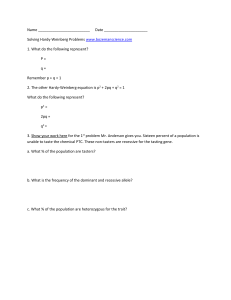p 2
advertisement
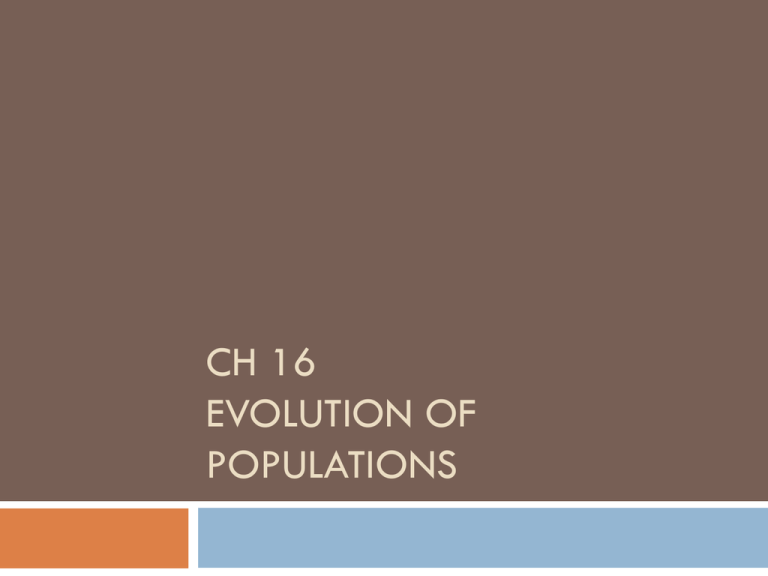
CH 16 EVOLUTION OF POPULATIONS Crash Course: Population Genetics https://www.youtube.com/watch?v=WhFKPaRnTdQ 16-1 Genetic equilibrium Population genetics: study of evolution from a genetic point of view Basically how populations of a species evolve But what is a population? Group of members of the same species living in the same area Sources of genetic variation 1. Three main sources Mutations: any change in sequence of DNA Replication mistakes Radiation/environmental causes 2. 3. recombination: reshuffling of genes Random pairing of gametes Bell curve # of individuals with that trait Many traits in nature show trends like this Phenotype continuum Number of phenotypes produced depends on how many genes control that trait Single gene traits- have two alleles Two distinct phenotypes Polygenic traits- controlled by two or more genes Results in multiple phenotypes Gene pool- all genes, including all different alleles, that are present in a population frequency (of an allele)- number of times alleles occur in a gene pool Percentage Genetic definition of evolution? Change in relative frequency of alleles in a population over time Phenotype frequency How often a specific phenotype is observed in a population? Can be written mathematically Frequency = # indiv. w/a particular phenotype total # of indiv. in population Hardy-Weinberg equilibrium https://www.youtube.com/watch?v=oG7ob-MtO8c When evolution is not occurring Allele frequencies remain the same In order for evolution to not occur, certain conditions must be met. Evolution Versus Genetic Equilibrium Hardy-Weinberg principle = Genetic Equilibrium • Random Mating – Equal opportunity to produce offspring • Large Population – Genetic Drift does not effect Allele Frequency • No Movement into or out of Population – The gene pool must be kept together (no new alleles) • No Mutations – Mutations cause new forms of alleles changing the frequency • No Natural Selection – All genotypes must have equal probability of surviving. Hardy-Weinberg equilibrium Allele frequency equation p+q=1 p = frequency of dominant allele q = frequency of recessive allele Together, they make 100% of alleles for a gene in that population If p = 34%, what is q? 0.66 If q = 19%, what is p? 0.81 Hardy-Weinberg equilibrium GENOTYPIC FREQUENCY EQUATION p2 + 2pq + q2 = 1 p2 = homozygous dominant frequency 2pq = heterozygous frequency q2 = homozygous recessive frequency If p = .46, what is p2? 0.2116 If p = .12, what is q2? 0.7744 = 77% If q =.31, what is 2pq? 0.4278 Worksheet Answers Practice Problems q = 0.55 a. q2 = 0.30 b. p = 0.45 (1 – q = p) c. p2 = 0.20 (0.45)2 d. 2pq = 0.50 Worksheet Answers Colorblindness 1. 2,500 2. 25 3. 0.01 4. 0.1 = 10% = q 5. 0.9 = 90% = p 6. 0.81 = 81% = p2 7. 0.18 = 18% = 2pq 8. 0.01 = 1% = q2 0.81 + 0.18 + 0.01 = 1 Worksheet Answers No freckles 1. 3,420 2. 513 3. q2 = 0.15 4. 0.39 = 39% = q 5. 0.61 = 61% = p 6. 0.37 = 37% = p2 7. 0.48 = 48% = 2pq 8. 0.15 = 15% = q2 Worksheet Answers 1. RR 0.09 p2 rr 0.49 q2 Rr 0.42 2pq R 0.3 p r 0.7 q How many of 7,000 carry free ear lobe allele? 2,100 (7,000 x 0.3) Worksheet Answers 3. B = 0.4 b = 0.6 a. BB = 0.16 (p2) b. Bb = 0.48 (2pq) c. Bb = 0.36 (q2) Worksheet Answers 4. 10% of 2,000 natives have recessive allele for psychic ability (witch doctor). p = 0.90 = 90% q = 0.10 = 10% How many witch doctors? 200 (2,000 x 0.10) Allele frequency of dom. Non-psychic? 0.90 Proportion of population: a. b. c. BB = 0.81 (p2) Bb = 0.18 (2pq) bb = 0.1 (q2) 16-2 Disruption of genetic equilibrium Mutation Occur at a relatively constant rate over time Can be sped up when exposed to mutagens Gene flow: process of genes moving from one population to another Immigration: moving into a population Emigration: moving out of a population Genetic Drift Alleles can become rare by chance Over time a series of chance occurrences can cause an alleles to become common in a population Effects of genetic drift are more dramatic with small population size Founder effect: change in allele frequencies as a result of migration of a small subgroup of a population Genetic Drift Section 16-2 Sample of Original Population Descendants Founding Population A Founding Population B Genetic Drift Section 16-2 Sample of Original Population Descendants Founding Population A Founding Population B Genetic Drift Section 16-2 Sample of Original Population Descendants Founding Population A Founding Population B Nonrandom mating Sexual selection: tendency of individuals to choose a mate with certain traits. Common in birds Peacock display Tropical birds of paradise - Papua New Guinea The amazing Lyrebird - Australia Natural selection Natural selection on a single gene traits can lead to changes in allele frequencies Natural selection on polygenic traits 3 possible effects Directional selection 2. Stabilizing selection 3. Disruptive selection https://www.youtube.com/watch?v=vCHdT9MWIaA 1. Directional selection When individuals at one end of curve have higher fitness than individuals in the middle or the other end Stabilizing selection When individuals near the middle have higher fitness than the individuals at either end Disruptive selection When individuals at upper and lower ends have higher fitness than individuals near the middle 16-3 Formation of Species As new species evolve, populations become reproductively isolated from each other Reproductive isolation: when two members of populations cannot interbreed and produce fertile offspring Separate gene pools Isolation Mechanisms Geographic Isolation: - separation of animals in a specific region - formation of river, canyon, mountain Isolation Mechanisms Behavioral Isolation: - differences in courtship or reproductive behaviors -meadowlark songs Temporal isolation: -two or more species reproduce at different times -orchids Formation of species Allopatric speciation: when species arise from geographic isolation Different places https://www.youtube.com/w atch?v=cSgulsydsQU Reproductive isolation Prezygotic isolation: premating isolation Species may live in different places Reproduce at different times Have different mating behaviors Postzygotic isolation: postmating isolation Hybrids may be weak Hybrids may be sterile Sympatric speciation Sympatric speciation: when two subpopulations become isolated while living in the same area Rates of speciation Gradualism: speciation at gradual and regular rate Punctuated equilibrium: periods of sudden, rapid change followed by periods of littelchange
